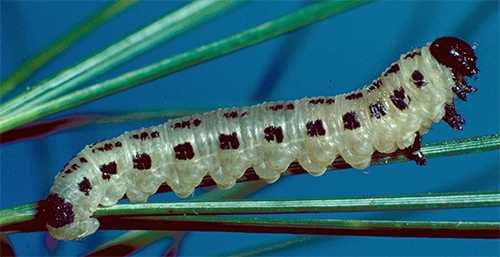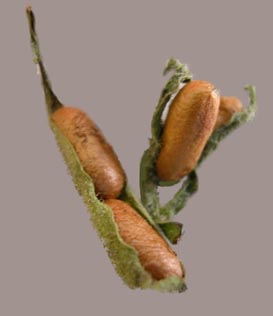Pine Sawflies
ENTFACT-410: Pine Sawflies | Download PDF
by Lee Townsend, Extension Entomologist
University of Kentucky College of Agriculture
Sawflies are members of the same insect order (Hymenoptera) that includes ants, bees, and wasps. The larval stage has a caterpillar-like body that may be brightly marked with stripes or spots. Some species change significantly in appearance as they grow, making identification confusing. Large numbers of sawflies can strip the needles from a tree in a short period. Several species can be found on pines in Kentucky.

Typical Sawfly Larva (Randall Blackburn, Smithsonian Institution, Bugwood.org)
Introduced Pine Sawfly
This distinctive sawfly has a black head and black body that is covered with yellow and white spots. The larvae prefer to feed on the needles of eastern white pine but also will eat Scotch, red, Austrian, jack, and Swiss mountain pine. Short leaf and Virginia pines have been attacked but usually are not heavily damaged.
Defoliation is most severe in the crown to upper half of the tree but heavily infested trees can be completely defoliated. If this occurs after the winter buds have formed, many branches or even the entire tree can be killed.
There are two generations each year. Larvae of the first generation feed on needles from the previous year. Young sawflies eat the more tender outer parts of the needles while older larvae consume them entirely. They are full-grown (about inch long) in July. The second generation of this sawfly feeds on both old and new needles during August and September.
Redheaded Pine Sawfly
This distinctive larva has a red head with 2 black eye spots and six rows of black spots along a yellow-white body. They are 1 to 1-1/4 inches long when full grown.
The redheaded pine sawfly can be very destructive, attacking trees 1 foot to 12 feet tall. Infestations may be worse on trees already under stress due to a poor site or if under severe competition from other trees. This species attacks jack, short leaf loblolly, slash, red, Scots, and other 2- and 3-needled pines.
There are two generations each year, larvae can be found feeding in late June and in late August to early September. They feed gregariously on new and old needles, as well as the tender bark of young twigs. They generally feed downward from the top. Mature larvae drop to the soil and pupate; they pass the winter in this stage.

European Pine Sawfly
European Pine Sawfly
European pine sawfly larvae are gray-green with black heads, there is a dark gray stripe along each side of the body (see a short video of the larvae here). They can feed on many pines including Scotch, Eastern white, and Austrian. The insect spends the winter as eggs deposited in pine needles. Eggs hatch in the spring and the larvae are active from late April to mid-June, feeding on the previous year's needles. The ground beneath heavily infested trees can become covered with sawdust-like droppings from the insects. Full grown larvae, about 1 inch long, drop to the ground and pupate in a small brown cocoon. There is one generation each year.
Trees are seldom killed by the feeding of this insect during a single season but mortality can occur following two to three consecutive years of heavy defoliation.
White Pine Sawfly
This sawfly is a pale yellow caterpillar with a black head and four rows of black spots along its body. It feeds primarily on old and new needles of white pine. The larvae can be found from late June to August. This insect passes the winter as a pupa in a brown cocoon on the ground.

White Pine Sawfly (E. Bradford Walker, Vermont Department of Forests, Parks and Recreation, Bugwood.org)
Loblolly Pine Sawfly
The loblolly pine sawfly, a long time pest in Arkansas, has attacked loblolly pines in western Kentucky during some years. The larvae, about 1-1/4 inches long when full grown, have a chocolate brown head and dull green body. There are heavy black stripes along each side with two lighter stripes below them. This insect is a spring and summer feeder that is found most often on medium to large trees in forest stands.
General Sawfly Life Cycle

Sawfly Pupae
Female sawfly wasps have a saw-like plate that is used to make slits in pine needles. Their eggs are then inserted into the small openings. After egg hatch, the small larvae begin to feed on needles. Individual species are active at different times of the year and some have more than 1 generation.
Sawfly larvae resemble the caterpillars of moths and butterflies with a visible difference. While butterfly and moth caterpillars have 2 to 5 pairs of fleshy prolegs on the abdomen; sawflies have more than 5 pairs. This distinction is important because the biological insecticide (Bt or Bacillus thuringiensis) that works well against butterfly and moth caterpillars is not effective against sawfly larvae.
After feeding for three to four weeks, mature larvae spin a cocoon that turns brown and resembles a bud tip. The adult will emerge from the pupal case and start the life cycle again.
Sawfly Control
Sawfly populations are usually controlled by combinations of natural enemies, predators, starvation, disease, or unfavorable weather. Outbreaks can occur when natural control does not produce high mortality. Regular inspection of pines will help to detect sawfly infestations before the larvae reach a size that can cause significant defoliation. Since eggs are laid in clusters, feeding by groups of larvae can cause unsightly damage to ornamental or landscape plantings as well as tree nurseries.
If only a small number of colonies are present and accessible, they can be handpicked, shaken off, or pruned from the tree and destroyed.
Some of the insecticides that can be used for sawfly control are listed below by the common name of the active ingredient (in parentheses) followed by an example brand name. Recognizing the pesticide common name allows you to find comparable products that contain the same active ingredient. Be sure to read the product label carefully before purchasing any pesticide.
- (acephate) Orthene Turf, Tree & Ornamental Spray
- (azadiractin) Neem – various products
- (bifenthrin) Ortho Houseplant & Garden Insect Killer
- (carbaryl) Sevin
- (cyfluthrin) Bayer Advanced Garden Multi-Insect Killer Concentrate
- (esfenvalerate) Ortho® Bug-B-Gon Garden & Landscape Insect Killer Concentrate
- (permethrin) Ortho Mosquito B Gon Tree, Shrub, and Lawn Spray
- (spinosad) Captain Jack’s Deadbug Brew, various products
Insecticidal soaps may be effective if the insects are contacted directly by the spray. Frequent inspection of trees will allow early detection of damaging infestations.
Revised: 7/19
CAUTION! Pesticide recommendations in this publication are registered for use in Kentucky, USA ONLY! The use of some products may not be legal in your state or country. Please check with your local county agent or regulatory official before using any pesticide mentioned in this publication.
Of course, ALWAYS READ AND FOLLOW LABEL DIRECTIONS FOR SAFE USE OF ANY PESTICIDE!
Images: Lee Townsend, University of Kentucky Entomology.
